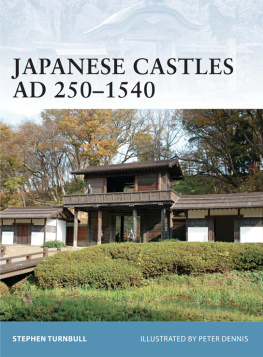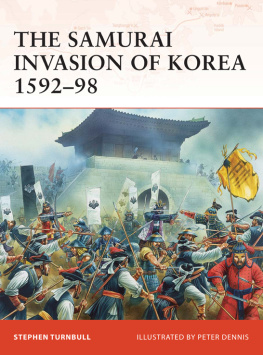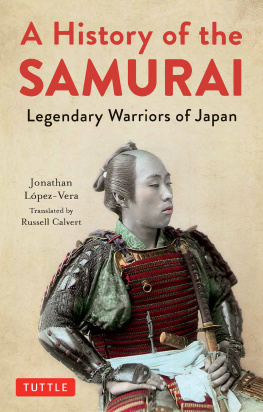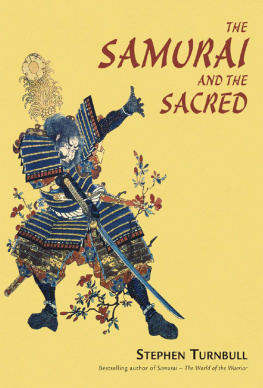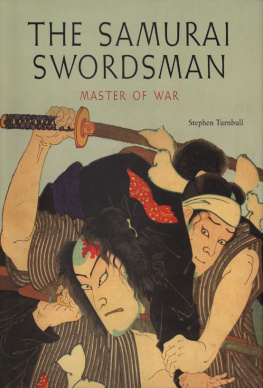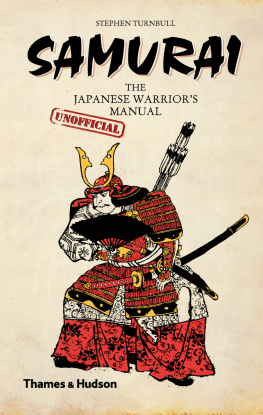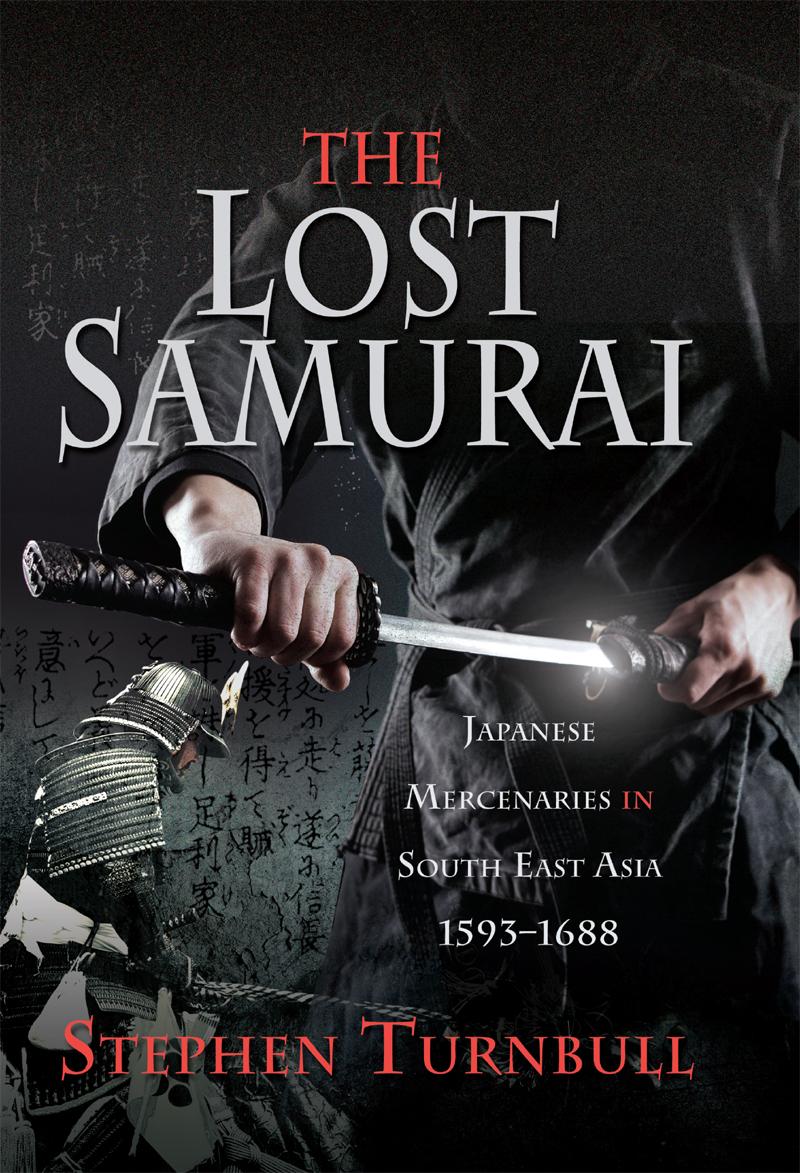
THE
L OST S AMURAI
J APANESE M ERCENARIES IN
S OUTH E AST A SIA
1593-1688
This book is dedicated to Francis Turnbull:
my grandson and fellow historian.
THE
L OST
S AMURAI
J APANESE M ERCENARIES IN
S OUTH E AST A SIA
1593-1688
S TEPHEN T URNBULL
THE LOST SAMURAI
First published in Great Britain in 2021 by
Frontline Books
An imprint of
Pen & Sword Books Ltd
Yorkshire - Philadelphia
Copyright Stephen Turnbull, 2021
ISBN 978 1 52675 898 9
eISBN 978 1 52675 899 6
Mobi ISBN 978 1 52675 900 9
The right of Stephen Turnbull to be identified as the author of this work has been asserted by him in accordance with the Copyright, Designs and Patents Act 1988.
A CIP catalogue record for this book is available from the British Library
All rights reserved. No part of this book may be reproduced or transmitted in any form or by any means, electronic or mechanical including photocopying, recording or by any information storage and retrieval system, without permission from the Publisher in writing.
Pen & Sword Books Ltd incorporates the Imprints of Aviation, Atlas, Family History, Fiction, Maritime, Military, Discovery, Politics, History, Archaeology, Select, Wharncliffe Local History, Wharncliffe True Crime, Military Classics, Wharncliffe Transport, Leo Cooper, The Praetorian Press, Remember When, Seaforth Publishing and Frontline Publishing.
For a complete list of Pen & Sword titles please contact
PEN & SWORD BOOKS LTD
47 Church Street, Barnsley, South Yorkshire, S70 2AS, England
E-mail:
Website: www.pen-and-sword.co.uk
Or
PEN AND SWORD BOOKS
1950 Lawrence Rd, Havertown, PA 19083, USA
E-mail:
Website: www.penandswordbooks.com
Preface
Conventional understanding has it that almost all the wars fought by Japan prior to modern times were civil wars. The invasion of Korea in 1592 is usually cited as the only exception, but this book will show that some samurai, as Japans warriors are conventionally known, fought overseas on an individual basis for almost a century. Their operations may have been conducted on a much smaller scale than the Korea expedition, but through these campaigns the samurai of Japan wrote their own little-known chapter in the history of East Asia.
This book about the Japanese mercenaries began life following a suggestion in 2008 from David Karunanithy that I should write about them. I became immediately interested in the topic, and the project took on its initial shape in the form of a lecture I was privileged to present to the World History Association Conference held at Panasastra University, Siem Reap, Cambodia in January 2011. The comments made at the time and the helpful critical reactions to the papers contents, which were circulated as an unpublished manuscript, directed further research. This I undertook with the kind cooperation of the Siam Society in Bangkok among others. Information for the Japanese side came largely from Nagasaki Prefectural Library, whose staff were more than helpful.
I soon realised that the story had to be told within the wider context of Japans relations with places like Siam, Cambodia and the Philippines, and the impact placed upon those exchanges by the arrival of European colonial powers. The comparative dimension also developed into a key factor in my research. For example, the little-known story of the Japanese plans to invade the Philippines during the seventeenth century provided fascinating parallels to the Second World War, a topic I was able to place under the scholarly scrutiny of the officers of the US Naval War College in Newport RI, whom I addressed in 2013. Much useful feedback was also provided following my lectures on the topic in Fort Worth, Kennesaw State University in Atlanta and the University of Boston. I am most grateful for those invitations to speak: nothing concentrates a scholars mind better than to have his ideas bounced back from a learned audience!
I would also like to thank Michael Charney of SOAS for suggestions regarding south-east Asian warfare, while Jonathan Clements kindly provided me with translations from Chinese for the chapter on Koxinga, and drew my attention to certain rare Japanese sources. In particular I warmly acknowledge the scholarship and friendly cooperation of Adam Clulow, whose outstanding work on the Dutch presence in south-east Asia is key to understanding so much of the background to what follows.
In terms of style, when using quotations from the diaries of servants of the East India Company I have modified the original spelling for the benefit of readers whose first language is not English. Japanese names are given in the conventional style of family name/clan name first, personal name second, e.g. Toyotomi Hideyoshi not Hideyoshi Toyotomi. Note, however, that the personal name is normally used as the identifier in a textual narrative. So, for example, Hideyoshi ordered an attack, not Toyotomi ordered an attack.
Chapter 1
The Japanese Wild Geese
In 1639 a Portuguese missionary and traveller called Sebastien Manrique (15901669) visited the kingdom of Arakan in Burma, and wrote as follows:
as the news of my arrival had already spread, the Japanese Christians came with their Captain. They had accompanied the King, in whose guard they were serving. As soon as they had learned where I was they had come to see me. Their Captain, called Leon Donno, came forward and knelt to me.
Manriques discovery that certain members of the Japanese Christian community in Arakan were serving as its kings bodyguard is the sole reference ever made to this particular instance of a phenomenon to be found throughout south-east Asia during the seventeenth century: the Japanese overseas mercenary.
As soldiers fighting for a foreign employer the followers of Leon Donno (the suffix dono was used to indicate a leader in Japanese) fitted the first element of the usual definition of a mercenary, which is that of a paid fighter who comes from outside the society for which he fights, is not part of its regular forces, and is motivated primarily by the desire for private gain. An individual mercenary may also possess a romantic tinge as a soldier of fortune journeying far from home to seek adventure, although sympathy tends to replace admiration for those mercenaries who experience by choice or coercion the life of The Wild Geese: the mournful expression first used for the Irish Catholic soldiers who fled to continental Europe after the Treaty of Limerick in 1691. Many of the Japanese Wild Geese we will encounter in the pages which follow shared with their Irish counterparts that same factor of religious exile, because the persecution of Christians prevented them from ever returning to Japan, whose rulers were ignorant of their very existence. Those men were indeed the lost samurai.
The elusive samurai
Throughout my long writing career I have always had a fatal weakness for a snappy title, and this book is no exception. Its lead title The Lost Samurai is an obvious play on the name of a well-known film, but together with the subtitle it introduces three expressions which need to be clarified at this stage. They are the use of samurai to identify the Japanese fighting men, mercenary for their conditions of service and south-east Asia for their area of operation.
Next page

